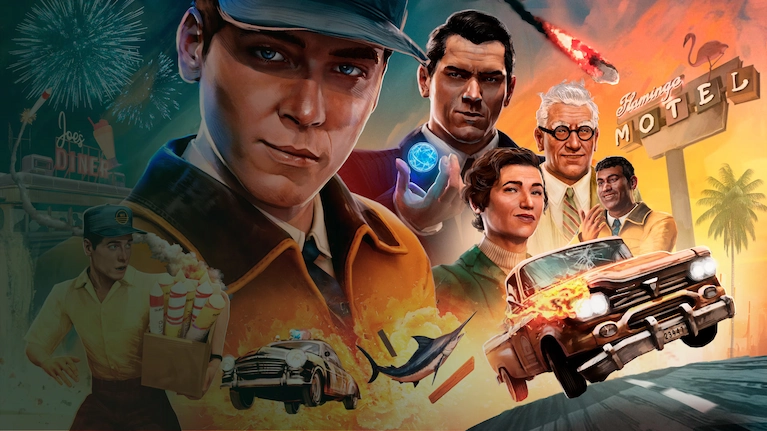The title Deliver at All Costs perfectly sums up the game itself: “Deliver the package—no matter what it takes!” Describing it any other way is genuinely difficult, as it’s a strange blend of comedy and drama. While the game constantly throws absurd delivery tasks at you, it also tells a surprisingly emotional story about a wealthy, dysfunctional family. This contrasting tone is both the game’s charm and, at times, its biggest flaw.
A Surprising Debut from Far Out Games
Deliver at All Costs is the first game by the Swedish studio Far Out Games—and interestingly, it’s published by Konami. What’s even more surprising is that the developers originally intended the game as a student project, which eventually evolved into a full release.
Welcome to 1950s Small-Town America
The story is set in a small American town during the late 1950s. You play as Winston Green, a man passionate about aerospace but down on his luck. Struggling financially, he takes a job as a delivery driver for We Deliver, a shipping company run by a wealthy family. As you begin completing your deliveries, the narrative slowly unfolds, revealing internal tensions within the family that runs the business.
Absurd Missions and Chaotic Fun
Gameplay in Deliver at All Costs is mostly lighthearted and full of strange, unexpected missions. One moment you’re guarding a mayor’s statue from bird attacks, and the next, you’re stealing from rival companies’ delivery vans. The variety is surprisingly rich, and the missions never stop being unpredictable.
Despite the goofy tone, the story gradually becomes more dramatic—especially the relationship between CEO Harald Gurter and his son Donovan. But here’s where the game struggles: the gameplay never shifts to match the drama. You’ll still be smashing into pedestrians and cars in absurd ways while serious storylines unfold, creating a tonal disconnect.
Tone and Logic Don’t Always Align
This contrast is especially noticeable with Winston himself. In cutscenes, he appears thoughtful and kind—but in gameplay, there are no consequences for running over pedestrians or causing mayhem. The lack of punishment systems makes the story’s emotional stakes feel disconnected from the world you’re interacting with. The result? The drama loses impact.
Voice Acting Shines
One of the game’s strongest points is the voice acting. Each character feels alive, and some performances truly bring depth to the cast. For example, Donovan comes across as a conflicted, morally gray figure—thanks to his voice actor’s impressive delivery. The developers also experiment with stylized slideshows to present backstories, which adds a creative flair to the storytelling.
A Bit Like Classic GTA – But Not Quite
The game is presented from a top-down isometric view, giving off classic GTA vibes. You begin each day in your apartment, hop into your car, drive through chaotic streets to the We Deliver office, accept a new mission, go on a bizarre adventure, and return home. This daily loop becomes repetitive after a while, but the mission variety helps soften that fatigue.
The open world is semi-open, meaning it’s not massive, and the available activities feel limited. Even when the map changes midway through the game, the core gameplay loop stays the same—leading to some repetitive tasks.
Drive Anything, But Don’t Expect Realism
You can drive almost any car in the city, including classic vehicles from the 1950s. However, you can’t store cars in garages or save them for later—which feels like a missed opportunity. The physics system, though, is one of the game’s highlights. You can destroy nearly everything, from buildings to signs and fences. It’s fun, chaotic, and completely over the top.
Unfortunately, the driving mechanics themselves are overly sensitive. Cars are twitchy, and handling is inconsistent—especially when physics objects like helium tanks affect your ride. Sometimes, the game clearly wants driving to feel clumsy, perhaps to reflect Winston’s inexperience, but even so, the handling could’ve used more polish.
Play “Badly” to Have More Fun
Interestingly, the game seems to reward chaotic behavior. When I tried to play cleanly and follow rules, the experience felt dull. But when I embraced the madness—ignoring traffic rules, smashing obstacles, causing destruction—the game became much more entertaining. It feels like Deliver at All Costs was designed to be enjoyed “incorrectly.”
Lack of Rules Hurts Immersion
The absence of any punishment system really affects the overall challenge. You can run over citizens or demolish property without any consequences. The one time a police chase occurs, it involves remote-controlled cars—during a mission where you cause chaos with an RC vehicle. It’s hilarious, but it makes you wonder: why aren’t there consequences when you destroy the city with a regular delivery van?
Solid Visuals and Fantastic Destruction Physics
Visually, the game looks decent for an indie title, but the real technical highlight is the destructible environment. Almost every object in the world can be smashed, and it adds a satisfying layer to the gameplay. The camera angles are fixed in two directions, but the level design accommodates this limitation well.
A Jazzy, Retro Soundtrack
The game’s soundtrack features a mix of classic jazz and rock from the 1950s, giving it a unique identity. The custom tracks are catchy and do a good job of enhancing the mood without becoming repetitive or annoying.
Final Verdict – A Wild Ride with Mixed Results
Deliver at All Costs offers a 10-hour experience that sits in the middle of the spectrum—not bad, but not particularly great either. It has charming moments, some genuinely fun gameplay, and solid voice acting. However, its tonal inconsistencies, repetitive loops, and lack of consequences hold it back from being a standout title.
For me, the first two hours were a blast. But by the midpoint, the experience began to drag. Still, if you can embrace the chaos and don’t take the game too seriously, there’s a fun, quirky ride waiting for you.
